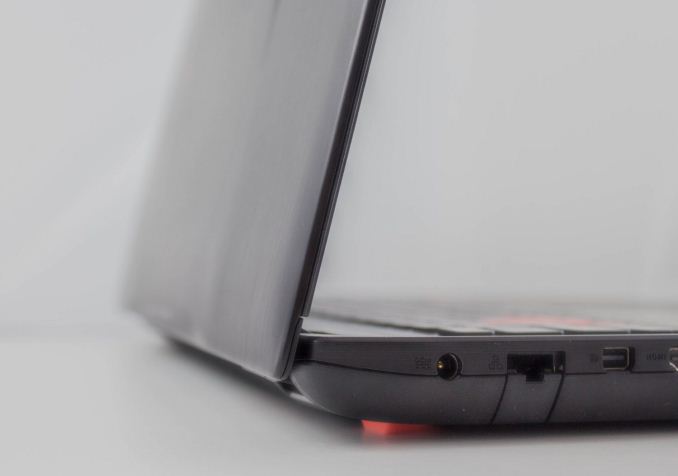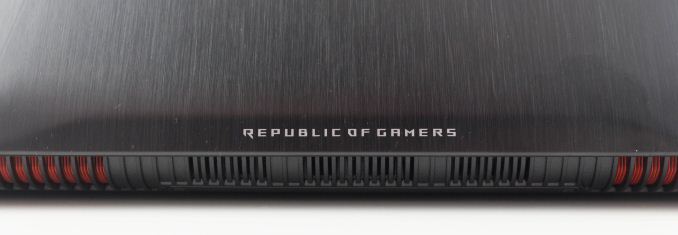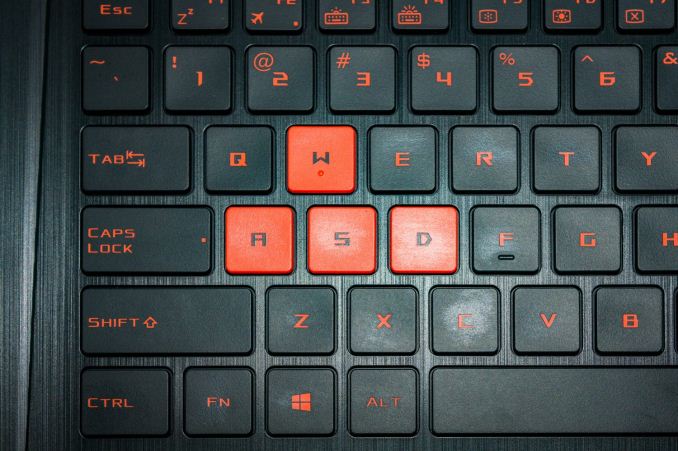The ASUS ROG Strix GL502VS Review: Mainstream GTX 1070 with G-SYNC
by Brett Howse on December 9, 2016 8:00 AM ESTFinal Words
ASUS has built a powerful gaming system, with all the latest technology inside. The Core i7-6700HQ is well known, and very capable. There will likely be a Kaby Lake update for quad-core processors soon, and we’ll see how they compare, but for now this is a capable CPU for a portable computer. The NVIDIA GTX 1070 is a very large step up from the GTX 970M, with performance that is right in-line with two GTX 980M cards in SLI. We’ve been waiting for FinFET for years on the GPU side, and it has paid off. In addition, it has up to 8 GB of GDDR5, and if you are interested in this notebook be very sure you are getting the 8 GB model since games like Rise of the Tomb Raider already use more the 4 GB on maximum settings.
As seems to be the case with ASUS, they also make sure the rest of the system is up to par as well. The single channel RAM is unfortunate, but also a bonus if you want to add another 16 GB yourself, since you’d only need to buy one more SO-DIMM. There is also USB 3.1 Gen 2, offering up to 10 Gbps of bandwidth, although it doesn’t support Thunderbolt 3. There are three USB 3 ports as well, meaning you have one foot in the present and one in the future. Gigabit Ethernet is pretty much expected on a gaming notebook, and it’s not missing either, but the Intel 8260 wireless adapter is one of the best we’ve ever used, offering great connection and transfer speeds, and a trouble-free experience. For those that need to connect to an external display, ASUS offers both HDMI and mini Display Port as well.
The included 62 Wh battery is pretty small for a system of this size, and that impacts the battery life quite a bit. The battery life on any gaming notebook is generally not very good though, and you pretty much need to use this on a desk plugged into a wall if you are going to use it for any length of time.
For a notebook of this size and power, the fact that ASUS got it under five pounds is a nice touch too. If you look around at the competition, something like the MSI GT62VR with GTX 1070 is about 6.5 pounds, and that is a big difference if you do need to travel with it.
The build quality is just average though, and the materials are decidedly low-end. There is nothing wrong with a plastic for a notebook body, but there are definitely different grades of plastic, and the one chosen for the GL502VS is very low quality. The keyboard is middle of the road, and while it is backlit, it only offers red backlighting when much of the competition offers choice here. The trackpad is not something I would want to use daily, so a mouse is almost a necessity. Some attention to detail here would go a long way, since this is the main part of the notebook experience. ASUS can do better, because they do offer better options on some of their other notebooks.
The cooling solution seems to get the job done, but once again ASUS has done better in other notebooks. The cooling vents blow directly onto the display when it is open, which causes the laptop to get quite warm, especially around the hinge where it is as high as 55°C. ASUS has a hinge-forward design on the G752 to avoid this exact issue, but it is not leveraged here. At the end of the day, it can keep the GTX 1070 cool enough to avoid throttling, but only just.
Despite the less than amazing chassis, the ASUS ROG Strix GL502VS does offer a competitive value for what is offered. The pricing is reasonable for a powerful gaming laptop, starting around $1275 for the GTX 1060 GL502VM with no SSD. The GTX 1070 GL502VS is closer to $1650 at the moment though, which starts to put it very close to some of the competition, or even above something like the MSI GT62VR depending on sales. Gigabyte also offers the P35Xv6 in this size, but for a bit more money. If you are in the market for a 15.6-inch gaming notebook, the space is very competitive. ASUS needs to address some of the build quality to really stand out in this space.















54 Comments
View All Comments
nathanddrews - Friday, December 9, 2016 - link
Is $1600 mainstream?Hopefully we see FreeSync (or G-Sync) laptops on the "low end" $800 laptops. Seems like a ripe market for Adaptive Sync technologies, given the lesser performance of GTX 960m and similar parts.
close - Friday, December 9, 2016 - link
Given the prices I saw recently on deeply flawed (unbalanced) gaming machines, ~$1600 for something that comes with more than decent CPU, GPU and SSD might as well be called mainstream. The rest is still compromised as opposed to a proper gaming machine (small screen, integrated keyboard and touchpad) but at least you get a reasonable package for a relatively reasonable price.Do not compare it to a desktop. The desktop will still be twice as cheap and a lot more powerful for a long time.
xenol - Friday, December 9, 2016 - link
Find me a complete desktop system (that includes all of I/O) that performs about the same for half the cost.sorten - Friday, December 9, 2016 - link
It would be difficult to find a comparable desktop for the comparison. You could probably go with an i5 65W CPU and it would significantly outperform the laptop's 45W i7. The 1070 is the same for desktop and mobile, but much more thermal headroom on the desktop. Memory and SSDs are cheap. I also wouldn't count the cost of the monitor in the comparison, because the only time I wouldn't dock the laptop so I could use my 27" monitor would be in the rare trip to a hotel or similar place.The other thing is that anyone who is building a desktop for gaming is only replacing one or two components. For example, I could build a faster desktop gaming system than this laptop by just spending the $400 on the GPU. I've had the same case, PSU, optical drive, etc. for probably 7 or 8 years.
Samus - Sunday, December 11, 2016 - link
The other thing to keep in mind is you can build a mini ITX system with an i7 and GTX1070 while still being incredibly tiny, less expensive and more capable (aside from being slightly more bulky and lacking battery power.)But that's the real killer with gaming laptops. Unless they are DTR's, they are too weak in graphics performance, and when they are DTR's, battery life is a joke anyway.
close - Tuesday, December 13, 2016 - link
@xenol, if it's any easier for you to understand read it as "performance/$". Or do you specifically want me to lookup some desktop CPUs/GPUs that are gimped by thermal headroom to match the equivalent laptop ones, a case that allows for close to 0 upgradeability, a 15" mediocre screen, crappy keyboard, integrated buzzers... erm, speakers, and a touchpad instead of a mouse?I was talking more of a hypothetical equivalent since it's hard to build a desktop that matches *any* gaming laptop in compromises. Yeah, I get that if you want portability a laptop is the way to go. It's still a severely compromised machine, it's still extremely expensive for the hardware but maybe the difference is how much "portability" costs.
Donny2005UK - Wednesday, January 11, 2017 - link
https://www.amazon.com/Lenovo-Ideacentre-Y700-Desk... Sorry cheapest I could find with a decent cpumrmcmurren - Wednesday, February 1, 2017 - link
hey if you are intested i am selling my desktop with better specs for a great price 1200email me at mrmcmurren@gmail.com
specs as follows
BLUETOOTH: None
CASUPGRADE: None
CD: 24X Double Layer Dual Format DVD+-R/+-RW + CD-R/RW Drive (BLACK COLOR)
CD2: None
COOLANT: Standard Coolant
CPU: Intel(R) Core� i7-3820 Quad-Core 3.60 GHz 10MB Intel Smart Cache LGA2011 (All Venom OC Certified)
CS_FAN: Maximum 120MM Color Case Cooling Fans for your selected case
FA_HDD: None
FAN: Asetek 510LC Liquid Cooling System 120MM Radiator & Fan (Enhanced Cooling Performance + Extreme Silent at 20dBA) (Single Standard 120MM Fan)
FLASHMEDIA: None
GLASSES: None
HDD: 2TB (2TBx1) SATA-III 6.0Gb/s 64MB Cache 7200RPM HDD (Single Drive)
HDD2: None
IEEE_CARD: None
MEMORY: 16GB (4GBx4) DDR3/1866MHz Quad Channel Memory (Corsair Vengeance [Free upgrade from 1600MHz Major Brand])
MONITOR: None
MONITOR2: None
MONITOR3: None
MOTHERBOARD: (3-Way SLI/CrossFireX Support) ASUS P9X79 LE Intel X79 Chipset Quad Channel DDR3 ATX w/ Remote GO!, 7.1 HD Audio, GbLAN, 3 Gen3 PCIe X16, 2 PCIe X1 & 1 PCI
NETWORK: Onboard Gigabit LAN Network
OS: Microsoft(R) Windows 8 Pro (64-bit Edition)
OVERCLOCK: No Overclocking
POWERSUPPLY: 800 Watts - Standard Power Supply - SLI/CrossFireX Ready
SOUND: HIGH DEFINITION ON-BOARD 7.1 AUDIO
SPEAKERS: None
TEMP: None
TUNING: None
TVRC: None
USB: None
USBFLASH: None
USBHD: None
USBX: None
VIDEO: GTX 1070 AMP Mini
JoeyJoJo123 - Friday, December 9, 2016 - link
Desktop PCs are cheaper, and are more serviceable, and you avoid the pitfalls of going with a prebuilt system loaded with adware, or in the worst case with Lenovo's Superfish, blatant malware. However, I think you're overestimating the cost of PC ownership, and assume that a complete PC system with peripherals is _half_ the cost of a gaming laptop.GTX 1070 laptop video cards are very roughly comparable to desktop GTX 1070 performance, and Nvidia's gone a long way to help bridge the gap between mobile and desktop class performance. A balanced GTX 1070 PC build will cost ~$1000, with no peripherals or OS. Add in a basic 1080p monitor, mouse, keyboard, etc. and you're at $1250 or so. So the $1600 laptop isn't a farcry from what PC build enthusiasts would claim.
You pay about a 25% premium, I'd think for the compactness and convenience of a fully ready platform. But given that time is a resource, it's not an unjust cost for people who just want a system to be ready without the hassle of the PC building research, parts acquisition, and assembly.
These days prebuilt systems are cheaper than ever, so the argument that building your own PC saves a lot of money is losing its argument. I still do it as it's a fun hobby for me, but I know it's not for everyone.
xenol - Friday, December 9, 2016 - link
I'm poking fun of the desktop fanboy that every time they say "I can make a desktop build for cheaper!" they seem to fail to remember a laptop is a complete system. I'm all for price comparing, but please, make it as apples to apples as possible.It's like every time someone goes "I can make a $400 PC that can best a PS4" fails to account for the fact a PS4 also comes with a $60 controller and a BD drive. I mean, as a pure gaming machine, maybe. But at the same time, if I wanted something that could replace the PS4 as much as possible, I need that BD drive.
I mean, I didn't buy a PlayStation just to play games. I bought it because it's also a media player.